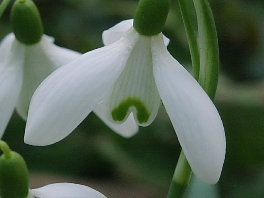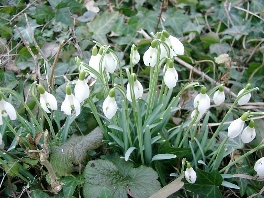 When the snowdrop blossoms the winter is finally over.
When the snowdrop blossoms the winter is finally over.
Nearly everybody knows this happy message of the fragile white snowdrop.
But only few people know, that the snowdrop ist a herbal remedy as well. Even in old herbal books you will not find the snowdrop.
The bulb of the snowdrop can help to slow down alzheimer's disease
and it also helps against poliomyelitis and neuralgia.
Medicinal Uses
- Alzheimer's disease
- Memory problems
- Poliomyelitis
- Trigeminal neuralgia
- Nerve pain
- Myasthenia
- Menses forcing
Information
| Used Parts: | Bulbs |
| Substances: | Galantamin, Lycorin |
| Time to collect: | Late spring |
Methods

Snowdrop, the secret herbal remedy
The snowdrop is a strange remedial herb.It was not known as a herbal remedy in antique times and it was unknown in the middle ages of middle and west europe. Because of this we don't have a tradition to use the snowdrop for medical purposes. For most people the snowdrop is just a nice flower.
Snowdrop in the Caucasus Mountains
In the Caucasus Mountains people use the snowdrop of this area (Galanthus woronowii) already for a long time.Old people eat the bulbs to strengthen their brain and to feel younger.
If children are ill from poliomyelitis, they are treatet with a tea from the bulbs. Usually these kids recover without further problems from the poliomyelitis.
Substances of the snowdrop against Alzheimer's disease
Scientists from Bulgaria examined the snowdrop ands its use in the Caucasus Mountains. They found the alkaloid Galantamin (or Galanthamin).This substance can slow the development of Alzheimer's disease but it is not able to heal Alzheimer's disease.
Because there are a lot of people who suffer from Alzheimer's disease there are not enough snowdrops growing worldwide.
Therefore scientists searched for a way to build Galantamin artificially. Finally they found a method and now a medicine with artificial Galantamin is available.
Galantamin is also helpful against neuralgic pain.
Other medicinal uses
Beside its abilities in treating the nervous system the snowdrop can also activate the menses.I am sure, there are a lot of other possible uses, but the ability to slow down Alzheimer's disease is so strong, that nobody asks for other uses.
View: Flower Essences: Snowdrop Essence
Plant description
 The snowdrop origins from the Caucasus Mountains and Southern Europe.
The most spreaded species, Galanthus nivalis, is growing in the gardens of Middle and Western Europe
already for a long time.
The snowdrop origins from the Caucasus Mountains and Southern Europe.
The most spreaded species, Galanthus nivalis, is growing in the gardens of Middle and Western Europe
already for a long time.
The snowdrop grows from a small bulb, that is sitting near the surface of the ground.
As soon as the frosty weather disappears and it gets warmer, narrow leaves are looking through the soil. The buds have their own leaves to protect them from cold temperatures.
The young sprouts of the snowdrop can produce a little bit heat to melt the snow in their surroundings.
Only few days after the bulbs show up, the Snowdrop starts to blossom. The flowers are white, very fragile and hang on the stalk.
At the outside the flowers have three white petals and at the inside there are three connected petals that are white and green.
The seeds ripen after the end of the flowering. Ants like to carry the seeds around and thus spread the snowdrop.
Beside the Galanthus nivalis there are lots of other kinds of Snowdrop. There is also the Spring Snowflake, a brother of the Snowdrop. They all have the same medical uses.
